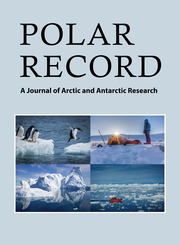Crossref Citations
This article has been cited by the following publications. This list is generated based on data provided by
Crossref.
Guil, Noemi
Rodrigo, Eva
and
Machordom, Annie
2015.
Soil tardigrade biodiversity with the description of a new eutardigrade genus and its phylogenetic position.
Systematics and Biodiversity,
Vol. 13,
Issue. 3,
p.
234.
Vecchi, Matteo
Cesari, Michele
Bertolani, Roberto
Jönsson, K. Ingemar
Rebecchi, Lorena
and
Guidetti, Roberto
2016.
Integrative systematic studies on tardigrades from Antarctica identify new genera and new species within Macrobiotoidea and Echiniscoidea.
Invertebrate Systematics,
Vol. 30,
Issue. 4,
p.
303.
Smykla, Jerzy
Porazinska, Dorota L.
Iakovenko, Nataliia S.
Devetter, Miloslav
Drewnik, Marek
Hii, Yii Siang
and
Emslie, Steven D.
2018.
Geochemical and biotic factors influencing the diversity and distribution of soil microfauna across ice-free coastal habitats in Victoria Land, Antarctica.
Soil Biology and Biochemistry,
Vol. 116,
Issue. ,
p.
265.
Zawierucha, Krzysztof
Stec, Daniel
Lachowska-Cierlik, Dorota
Takeuchi, Nozomu
Li, Zhongqin
and
Michalczyk, Łukasz
2018.
High Mitochondrial Diversity in a New Water Bear Species (Tardigrada: Eutardigrada) from Mountain Glaciers in Central Asia, with the Erection of a New GenusCryoconicus.
Annales Zoologici,
Vol. 68,
Issue. 1,
p.
179.
Kaczmarek, Łukasz
Parnikoza, Ivan
Gawlak, Magdalena
Esefeld, Jan
Peter, Hans-Ulrich
Kozeretska, Iryna
and
Roszkowska, Milena
2018.
Tardigrades from Larus dominicanus Lichtenstein, 1823 nests on the Argentine Islands (maritime Antarctic).
Polar Biology,
Vol. 41,
Issue. 2,
p.
283.
Guidetti, Roberto
Massa, Edoardo
Bertolani, Roberto
Rebecchi, Lorena
and
Cesari, Michele
2019.
Increasing knowledge of Antarctic biodiversity: new endemic taxa of tardigrades (Eutardigrada; Ramazzottiidae) and their evolutionary relationships.
Systematics and Biodiversity,
Vol. 17,
Issue. 6,
p.
573.
Fujimoto, Shinta
Suzuki, Atsushi C.
Ito, Masato
Tamura, Takeshi
and
Tsujimoto, Megumu
2020.
Marine tardigrades from Lützow-Holm Bay, East Antarctica with the description of a new species.
Polar Biology,
Vol. 43,
Issue. 6,
p.
679.
Kaczmarek, Łukasz
Mioduchowska, Monika
Kačarević, Uroš
Kubska, Katarzyna
Parnikoza, Ivan
Gołdyn, Bartłomiej
and
Roszkowska, Milena
2020.
New Records of Antarctic Tardigrada with Comments on Interpopulation Variability of the Paramacrobiotus fairbanksi Schill, Förster, Dandekar and Wolf, 2010.
Diversity,
Vol. 12,
Issue. 3,
p.
108.
Kaczmarek, Łukasz
and
Roszkowska, Milena
2021.
Zealandiscus gen. nov., a New Genus Erected in the Family Echiniscidae Thulin, 1928 (Heterotardigrada).
Annales Zoologici,
Vol. 71,
Issue. 3,
Tumanov, Denis V.
2022.
End of a mystery: Integrative approach reveals the phylogenetic position of an enigmatic Antarctic tardigrade genus Ramajendas (Tardigrada, Eutardigrada).
Zoologica Scripta,
Vol. 51,
Issue. 2,
p.
217.
Degma, Peter
and
Gábrišová, Nina
2023.
Limno-Terrestrial Tardigrada of Sub-Antarctic Islands—An Annotated Review.
Diversity,
Vol. 15,
Issue. 11,
p.
1109.
Pushkareva, Ekaterina
Elster, Josef
Kudoh, Sakae
Imura, Satoshi
and
Becker, Burkhard
2024.
Microbial community composition of terrestrial habitats in East Antarctica with a focus on microphototrophs.
Frontiers in Microbiology,
Vol. 14,
Issue. ,
Serga, Svitlana
Kovalenko, Pavlo A.
Maistrenko, Oleksandr M.
Deconninck, Gwenaëlle
Shevchenko, Oleksandra
Iakovenko, Nataliia
Protsenko, Yurii
Susulovsky, Andrij
Kaczmarek, Łukasz
Pavlovska, Mariia
Convey, Peter
and
Kozeretska, Iryna
2024.
Wolbachia in Antarctic terrestrial invertebrates: Absent or undiscovered?.
Environmental Microbiology Reports,
Vol. 16,
Issue. 6,
Mercado-Juárez, Ricardo A.
Valdespino-Castillo, Patricia M.
Merino Ibarra, Martín
Batista, Silvia
Mac Cormack, Walter
Ruberto, Lucas
Carpenter, Edward J.
Capone, Douglas G.
Falcón, Luisa I.
and
Franzetti, Andrea
2025.
What defines a photosynthetic microbial mat in western Antarctica?.
PLOS ONE,
Vol. 20,
Issue. 3,
p.
e0315919.

